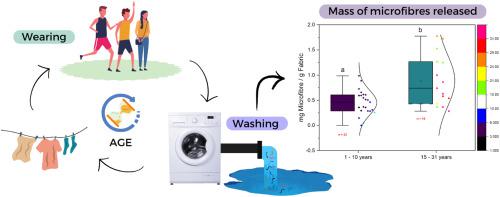当前位置:
X-MOL 学术
›
Environ. Pollut.
›
论文详情
Our official English website, www.x-mol.net, welcomes your feedback! (Note: you will need to create a separate account there.)
Effect of the age of garments used under real-life conditions on microfibre release from polyester and cotton clothing
Environmental Pollution ( IF 8.9 ) Pub Date : 2024-03-15 , DOI: 10.1016/j.envpol.2024.123806 Andreia N. Fernandes , Larissa Z. Lara , Francesca De Falco , Andrew Turner , Richard C. Thompson
Environmental Pollution ( IF 8.9 ) Pub Date : 2024-03-15 , DOI: 10.1016/j.envpol.2024.123806 Andreia N. Fernandes , Larissa Z. Lara , Francesca De Falco , Andrew Turner , Richard C. Thompson

|
The release of microfibres from fabrics during laundering represents an important source of plastic and natural microfibres to aquatic environments. Garment age - how long the garment has been used - could be a key factor influencing the rate of release, yet most studies of microfibre shedding have only assessed newly manufactured products. To this end, we quantified microfibre release during laundering in domestic washing machines from polyester (PES) and cotton garments (n = 38) used in real-life conditions for periods between 1 and 31 years with different use intensities. In addition, to better understand the factors involved in microfibre releases, fibre composition (different PES percentages) and type of garments (T-shirts, polo shirts, uniforms, sports shirts, and sweatshirts) were examined. All garments released microfibres during washing, while the older garments presented higher releases for clothing with a PES/cotton blend. In general, older garments (15–31 years) released nearly twice as many fibres when washed than newer garments (1–10 years). The mass of microfibres released was consistently greater in garments with a higher proportion of cotton than PES (up to 1.774 mg g in 2% PES and 0.366 mg g in 100% PES fabrics), suggesting that cotton might be released more readily such that the relative proportion of PES in the garments could increase over time. Additionally, SEM images showed fibre damage, with fibres from the older garments exhibiting more peeling and splitting. While it is important to note that the overall environmental footprint is undoubtedly reduced by keeping garments in use for longer periods of time, older garments were shown to release more microfibres.
中文翻译:

现实生活条件下服装使用年限对涤纶和棉质服装中微纤维释放的影响
洗涤过程中织物中释放的微纤维是水生环境中塑料和天然微纤维的重要来源。服装年龄(服装的使用时间)可能是影响释放率的关键因素,但大多数关于微纤维脱落的研究仅评估了新制造的产品。为此,我们量化了在现实生活条件下使用不同使用强度 1 至 31 年的聚酯 (PES) 和棉质服装 (n = 38) 的家用洗衣机洗涤过程中的微纤维释放量。此外,为了更好地了解微纤维释放所涉及的因素,还检查了纤维成分(不同 PES 百分比)和服装类型(T 恤、Polo 衫、制服、运动衫和运动衫)。所有服装在洗涤过程中都会释放出微纤维,而旧服装在 PES/棉混纺服装中释放出的微纤维含量更高。一般来说,旧衣服(15-31 年)在洗涤时释放的纤维数量几乎是新衣服(1-10 年)的两倍。棉花含量高于 PES 的服装中释放的微纤维质量始终较高(2% PES 中高达 1.774 mg g,100% PES 织物中高达 0.366 mg g),这表明棉花可能更容易释放,从而使得随着时间的推移,服装中 PES 的相对比例可能会增加。此外,扫描电镜图像显示纤维受损,旧衣服的纤维出现更多剥落和开裂。虽然值得注意的是,通过延长服装的使用时间无疑会减少总体环境足迹,但旧服装会释放更多的微纤维。
更新日期:2024-03-15
中文翻译:

现实生活条件下服装使用年限对涤纶和棉质服装中微纤维释放的影响
洗涤过程中织物中释放的微纤维是水生环境中塑料和天然微纤维的重要来源。服装年龄(服装的使用时间)可能是影响释放率的关键因素,但大多数关于微纤维脱落的研究仅评估了新制造的产品。为此,我们量化了在现实生活条件下使用不同使用强度 1 至 31 年的聚酯 (PES) 和棉质服装 (n = 38) 的家用洗衣机洗涤过程中的微纤维释放量。此外,为了更好地了解微纤维释放所涉及的因素,还检查了纤维成分(不同 PES 百分比)和服装类型(T 恤、Polo 衫、制服、运动衫和运动衫)。所有服装在洗涤过程中都会释放出微纤维,而旧服装在 PES/棉混纺服装中释放出的微纤维含量更高。一般来说,旧衣服(15-31 年)在洗涤时释放的纤维数量几乎是新衣服(1-10 年)的两倍。棉花含量高于 PES 的服装中释放的微纤维质量始终较高(2% PES 中高达 1.774 mg g,100% PES 织物中高达 0.366 mg g),这表明棉花可能更容易释放,从而使得随着时间的推移,服装中 PES 的相对比例可能会增加。此外,扫描电镜图像显示纤维受损,旧衣服的纤维出现更多剥落和开裂。虽然值得注意的是,通过延长服装的使用时间无疑会减少总体环境足迹,但旧服装会释放更多的微纤维。



























 京公网安备 11010802027423号
京公网安备 11010802027423号